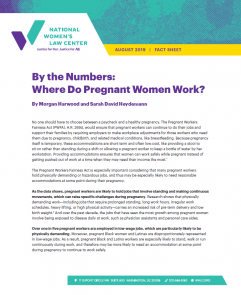 By Morgan Harwood and Sarah David Heydemann
By Morgan Harwood and Sarah David Heydemann
No one should have to choose between a paycheck and a healthy pregnancy. The Pregnant Workers Fairness Act (PWFA), H.R. 2694, would ensure that pregnant workers can continue to do their jobs and support their families by requiring employers to make workplace adjustments for those workers who need them due to pregnancy, childbirth, and related medical conditions, like breastfeeding. Because pregnancy itself is temporary, these accommodations are short-term and often low-cost, like providing a stool to sit on rather than standing during a shift or allowing a pregnant worker to keep a bottle of water by her workstation. Providing accommodations ensures that women can work safely while pregnant instead of getting pushed out of work at a time when they may need their income the most.
The Pregnant Workers Fairness Act is especially important considering that many pregnant workers hold physically demanding or hazardous jobs, and thus may be especially likely to need reasonable accommodations at some point during their pregnancy.
As the data shows, pregnant workers are likely to hold jobs that involve standing and making continuous movements, which can raise specific challenges during pregnancy. Research shows that physically demanding work—including jobs that require prolonged standing, long work hours, irregular work schedules, heavy lifting, or high physical activity—carries an increased risk of pre-term delivery and low birth weight. And over the past decade, the jobs that have seen the most growth among pregnant women involve being exposed to disease daily at work, such as physician assistants and personal care aides.
Over one in five pregnant workers are employed in low-wage jobs, which are particularly likely to be physically demanding. Moreover, pregnant Black women and Latinas are disproportionately represented in low-wage jobs. As a result, pregnant Black and Latina workers are especially likely to stand, walk or run continuously during work, and therefore may be more likely to need an accommodation at some point during pregnancy to continue to work safely.
Three in ten pregnant workers are employed in the same ten occupations. The jobs that pregnant women are most likely to occupy make up the backbone of our communities: elementary school teachers, nurses and home health aides. The people teaching our children and caring for our communities deserve to be able to work safely while they are pregnant. The PWFA will ensure that pregnant workers get the adjustments they need during the workday to stay safely employed.
Employers can accommodate pregnant workers: pregnant women make up a small share of the workforce, even in the occupations where they are most likely to work, which means that only a very small share of an employer’s workforce is likely to require pregnancy accommodations in any given year.
- Less than two percent of all workers in the U.S. are pregnant each year (1.5 percent in 2017, for example). Not all pregnant workers require any form of accommodation at work, so only a fraction of that small fraction will need accommodations.
- Three in ten (30.0%) pregnant workers are employed in the same ten occupations (see table below). Even in these occupations, pregnant women represent a small share of total workers. For example, pregnant women are most likely to work as elementary and middle school teachers but only three percent (3.2%) of all elementary and middle school teachers are pregnant women.
Many of the most common occupations for pregnant workers involve standing and making repetitive motions continuously on the job, which can pose challenges to some pregnant workers at some points in their pregnancy.
- Workers employed in four of the ten most common occupations for pregnant workers – retail salesperson; waiter or waitress; nursing, psychiatric and home health aide; and cashier – report continuously standing on the job. Prolonged standing at work has been shown to more than triple the odds of pregnant women taking leave during pregnancy or becoming unemployed.
- Another four of the ten most common occupations for pregnant workers – waiter or waitress; nursing, psychiatric and home health aide; cashier; and secretaries and administrative assistants – involve making repetitive motions continuously on the job. Repetitive motions have been shown to increase the likelihood of pregnant women taking sick leave.
More than one in five pregnant workers is employed in a low-wage job. Pregnant workers who hold low-wage jobs are especially likely to stand, walk or run continuously during work.
- More than one in five (20.9%) pregnant workers is employed in a low-wage job.
- Workers in the five most common low-wage occupations for pregnant women – cashiers; nursing, psychiatric and home health aides; waiters and waitresses; retail salespersons; and maids and housekeeping cleaners – reported continuously standing between 46-80 percent of the time and continuously walking or running between 51-82 percent of the time while at work.
- Pregnant workers in low-wage jobs may be particularly likely to need a clear legal right to receive accommodations because, in addition to the physically demanding nature of their jobs, they often face inflexible workplace cultures that make it difficult to informally address pregnancy-related needs. For instance, workplace flexibility—such as the ability to alter start and end times or take time off for a doctor’s appointment— is extremely limited for workers in low-wage jobs. Over 40 percent of full-time workers in low-wage jobs report that their employers do not permit them to decide when to take breaks; between two-thirds and three-quarters of full-time workers in low-wage jobs report that they are unable to choose their start and quit times; and roughly half report having very little or no control over the scheduling of hours more generally. This general lack of flexibility motivates and reinforces some employers’ refusal to make accommodations for pregnant workers in these types of jobs.
Pregnant Black women and Latinas are disproportionately represented in low-wage jobs. Many of these jobs require standing continuously or being exposed to disease daily on the job.
- Nearly one in three employed pregnant Black women and Latinas work in low-wage jobs (30.0 percent and 31.3 percent, respectively).
- Workers in many of the occupations where pregnant Black women most commonly work were likely to report standing and being exposed to disease daily while at work.
- The second most common occupation for pregnant Latinas – maids and housekeeping cleaners – is especially physically demanding. Data shows that 80 percent of maids and housekeeping cleaners stood continuously, 38 percent were exposed to disease daily, and 70 percent walked or ran continuously on the job.
Occupations that have seen the most growth among pregnant women in the past decade expose many workers to disease or infection daily; depending on the disease, this can pose particular challenges to some pregnant workers at some points during pregnancy.
- The number of pregnant women employed as speech and language pathologists has grown by over 82 percent since 2008. Nearly one-third of speech and language pathologists reported being exposed to disease daily while at work.
- The second and third occupations that have seen the most growth among pregnant workers – physician assistants and personal care aides – have both grown by roughly 70 percent (74.1% and 70.1%, respectively). More than 80 percent of physician assistants and 50 percent of personal care aides report being exposed to disease daily.
- When pregnant workers are exposed to some diseases, they face particular risks. For example, pregnant women with rubella are at risk for miscarriage or stillbirth and their developing fetuses are at risk for severe birth defects. Cytomegalovirus, a disease passed from pregnant woman to fetus in utero, can cause microencephaly and hearing loss in babies. Pregnant workers may need accommodations to avoid particular diseases at particular points in pregnancy.
The data shows that many pregnant workers face physical demands and hazards in their workplaces that can pose challenges to some pregnant workers during their pregnancy. Clear rights to reasonable accommodations on the job, which the Pregnant Workers Fairness Act provides, would help ensure that these workers are not forced off the job at the moment they can least afford it.
Methodology
This report uses data from the 2017 American Community Survey (ACS) 1- year estimates using IPUMS-USA and the U.S. Department of Labor (DOL) O*NET OnLine Database to provide a landscape of where pregnant women work and what physical demands they face on the job. The O*NET Program is developed under the U.S. Department of Labor/Employment and Training Administration and is the primary source of occupational information in the U.S. O*NET’s online database contains standardized and occupation-specific descriptors on approximately 1,000 occupations.
We began our analysis by determining the most common occupations among pregnant women in 2017 using IPUMS. We then searched for these occupations in O*NET’s database and investigated their descriptors under the category “Work Context – Physical Work Conditions” (a full list of indicators is available at https://www.onetonline.org/find/descriptor/browse/Work_Context/4.C.2/). We recorded the percent of employees in each occupation that responded standing, walking or running, making repetitive motions, or being exposed to disease or infections continuously or almost continuously while on the job. A cutoff of 40 percent or higher was used to determine if employees spent a significant amount of time performing these physical activities while at work. In a few instances, occupational definitions used by ACS did not correspond exactly with occupational definitions definitions used by O*NET. In these cases, we selected a similar but not exact O*NET occupation(s) to serve as a proxy for the most common occupations among pregnant women. More information about proxy occupations can be found in the endnotes section.

